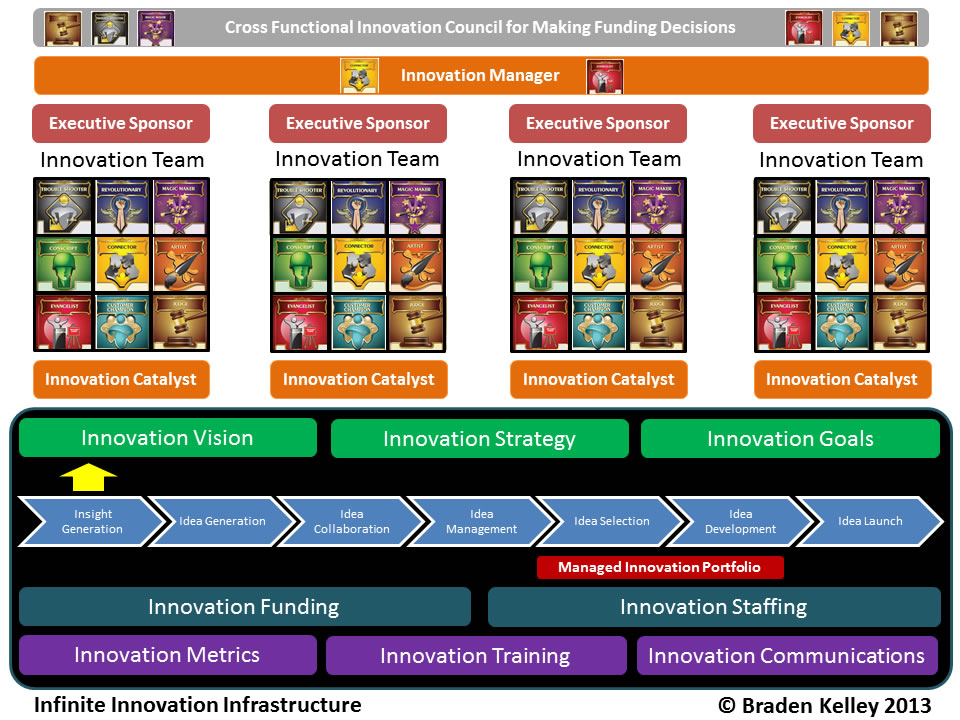
Many of you reading this have created or operated innovation or insights programs for organizations of a variety of sizes, or are curious about how to go about it.
Operating an innovation program or leading an insights group is definitely much different than creating one. In some ways it is easier, because things are already in place, but inheriting processes and expectations different than your preferences can also make things more difficult.
The folks at Aperio Insights are conducting research for a large utility company doing business in several states in the United States with a focus on electricity, natural gas, renewables, and ancillary services. Their research project is looking for a variety of perspectives from practitioners with experience in setting up a more formal and centralized innovation program or insights program (or ideally both), from scratch, where ad hoc and informal efforts occurred previously.
They’re looking for people who have been there and done that, tripped over the unseen obstacles in the dark, stubbed their toes, and are willing to share their perspectives on what they wished they had never done in setting up an innovation and insights program and what they would definitely do again.
OR, if you’ve inherited leadership of an existing innovation and insights program and were magically given the opportunity to start over and set it up from scratch, how would you go about it?
To jump start the thinking of those who get paid for your advice, let’s look at what a hand-picked group of guest experts have to say on the subject:
The Tony Ulwick Perspective:
 We have worked with Fortune 500 companies and other organizations over the past 26 years deploying Outcome-Driven Innovation (ODI), a proven innovation process with an 86 percent success rate. From my perspective, there are 5 major barriers companies must overcome before replacing luck with predictable innovation.
We have worked with Fortune 500 companies and other organizations over the past 26 years deploying Outcome-Driven Innovation (ODI), a proven innovation process with an 86 percent success rate. From my perspective, there are 5 major barriers companies must overcome before replacing luck with predictable innovation.
Across an organization, key managers and stakeholders must:
- Recognize that innovation is a process.
- Stop executing the innovation process backwards.
- Stop cobbling together incompatible innovation tools and methods.
- Budget the time and money needed to execute the process correctly.
- Recognize that new market research methods are required.
— Tony Ulwick, Strategyn founder and creator of the Jobs to be Done methodology (free pdf)
The Stephen Shapiro Perspective:
 In setting up an innovation and insights group from scratch, first want to define how you define success. What does this group hope to achieve? What issues is it addressing? What are the barriers to success?
In setting up an innovation and insights group from scratch, first want to define how you define success. What does this group hope to achieve? What issues is it addressing? What are the barriers to success?
This should drive all of the other decisions you make. Next, I would look at the process you use. The goal of any innovation group is to move from an ad hoc approach to one that is repeatable and predictable. Although most companies start with an idea-driven approach (which is ad hoc by its very nature), I encourage something I call “Challenge-Centered Innovation(TM)” Instead of asking for suggestions, ask for solutions to well-framed, important, and differentiating challenges. This fits in nicely with an insights-driven approach which looks for wants and needs in the marketplace and looks to develop solutions to address those. Beyond measures and process, one item you need to quickly address the organization model.
In general, you want a very small, centralized innovation team that helps defines the standards (e.g., measures, process, technology, etc). But the real work is pushed into the various businesses with only support from this team. Innovation should never be the domain of one group; rather it should be done where the money resides in the business. Although some capabilities can be centralized (e.g., market research), the ultimate decisions on how to use that information needs to be determined by the business. Of course there is no one-size-fits-all strategy for this and it needs to be tailored to your specific culture and needs.
— Stephen Shapiro, Speaker Hall of Fame Member and Author of Best Practices Are Stupid
The Geoff Tuff Perspective:
 Many corporate innovation leaders don’t have the luxury of starting an innovation and insights function “from scratch” as they’re often saddled with the inspiring (?) vision of a senior leader, a mandate to make use of resources who don’t fit in elsewhere, or the herculean task of filling a gap in a company’s growth plan which has few degrees of freedom to actually go and try something new. So on the rare occasions when this is the starting place, here are the top five things I consider strong precursors of success:
Many corporate innovation leaders don’t have the luxury of starting an innovation and insights function “from scratch” as they’re often saddled with the inspiring (?) vision of a senior leader, a mandate to make use of resources who don’t fit in elsewhere, or the herculean task of filling a gap in a company’s growth plan which has few degrees of freedom to actually go and try something new. So on the rare occasions when this is the starting place, here are the top five things I consider strong precursors of success:
- Have a crystal-clear sense for your level of ambition for the group: do you exist to advance to core business, to stretch it into adjacent spaces, to disrupt its business model, so some combination of all three? And if some combination, what proportion of your time and efforts will you spend on each?
- Develop clear operating procedures, rights and responsibilities relative to the rest of the company, especially regarding funding and what happens to innovation initiatives when they get to various stages of development.
- Start with a clean playing field and, as I write about in my forthcoming book Detonate, ignore the playbooks that have made the rest of the company successful.
- Focus on building complementary and nontraditional sources of insight such as ethnography that will supplement but not replace the insight machine of the rest of the company.
- Focus on driving economic value as quickly as possible and trumpeting it when you achieve it; a few quick, high-profile wins can help broaden your playing field and deepen your funding.
— Geoff Tuff, Deloitte principal and senior leader of the Doblin practice. Author of Detonate coming May 8 (pdf)
The Braden Kelley Perspective:
 It doesn’t matter whether your organization is B2B, B2C, a charity, a government entity, or all four. Every innovation and insights organization must begin with their customers in mind, and make sure that they have the buy-in of key internal organizations (their customers in this context) to pick up their outputs and turn them into new or renewed product and/or service offerings. Unless the rest of the organization converts your ideas into new sources of value for the organization or utilizes them to increase existing sources of value, then eventually your group will become the victim of budget cuts.
It doesn’t matter whether your organization is B2B, B2C, a charity, a government entity, or all four. Every innovation and insights organization must begin with their customers in mind, and make sure that they have the buy-in of key internal organizations (their customers in this context) to pick up their outputs and turn them into new or renewed product and/or service offerings. Unless the rest of the organization converts your ideas into new sources of value for the organization or utilizes them to increase existing sources of value, then eventually your group will become the victim of budget cuts.
Equally important is the creation of a common language of innovation. This includes the creation of a definition of “innovation” for the organization, along with an innovation vision, strategy, and goals. But for it to be sustainable you must also address funding, staffing, metrics, communications, training, portfolio management, and have a clearly defined and visualized innovation process. My Infinite Innovation Infrastructure integrates all of this together:

You will notice I’ve integrated my Nine Innovation Roles methodology from Stoking Your Innovation Bonfire into the Infinite Innovation Infrastructure because it is not whether any particular individual is innovative or not, but instead, everyone has a role to play in innovation.
Finally, innovation and insights in this context are very different, but yet complementary. Insights professionals typically focus on the uncovering new understandings at the intersection between customers and existing products and services, where innovation professionals are focused on uncovering new understandings about customers (and non-customers) that usually DO NOT link to existing products and services. Blending an optimization mindset with a creation mindset in the same organization can be a great challenge, and identifying where to keep things separate and where to create intentional overlap will be a balancing act as well.
— Braden Kelley, Keynote Speaker and Author of Charting Change and Stoking Your Innovation Bonfire
The Scott Anthony Perspective:
 The most critical thing the leader of a new insight and innovation group needs to consider in order to be successful is stakeholder expectations. Are stakeholders seeking insights and innovations that improve today’s business? Are they hoping to go build exciting new disruptive ventures? Or are they trying to create a more enabling culture of innovation? Those are distinctly different mandates, and a lack of clarity can lead a new leader to move in the wrong direction.
The most critical thing the leader of a new insight and innovation group needs to consider in order to be successful is stakeholder expectations. Are stakeholders seeking insights and innovations that improve today’s business? Are they hoping to go build exciting new disruptive ventures? Or are they trying to create a more enabling culture of innovation? Those are distinctly different mandates, and a lack of clarity can lead a new leader to move in the wrong direction.
Embedded in this area is my second key success factor: understanding how leaders define innovation. At some companies innovation is broad, covering everything from day-to-day advancements to more disruptive approaches; other companies mean it to only mean the bigger, bolder stuff. Of course, we have both a broad general definition of innovation (“something different that creates value”) and specific categories of innovation. But without common definitions, it is easy for an insights and innovation leader to miss the mark.
That leads then to the third and final point: knowing the specific problems that innovation should solve. One of the mistakes people make is they think innovation should be unbounded, and that a good leader lets hundreds of flowers bloom. I’ve never seen that work; letting hundreds of flowers bloom leads to a lot of undernourished flowers. Focus is the innovator’s friend. Identifying the specific problems to solve, such as improved employee engagement, higher customer retention, experimenting with a new technology, or winning in a particular customer segment, improves the ability to innovate for impact.
— Scott Anthony, Innosight Managing Director and author of Dual Transformation (mini pdf)
Now It’s Your Turn to Share
So innovation and insight practitioners, now that you’ve heard some inspiration from five carefully selected thought leaders, it’s your turn to jump into the tactical details and share your thoughts with researchers about HOW you would build a successful innovation and insights program from a blank canvas.
But wait!
It gets better, not only will you be able to help fellow innovation and insights practitioners get their program started on the right foot, but people accepted into the research program will be PAID $250 for an hour of their brainpower.
Aperio Insights are interviewing experienced client-side innovation and research leaders to help gather ideas on how to setup an effective consumers insights and innovation team, including tactical things like how to inform the rest of the organization that this function is now in place and how to prioritize the objectives of diverse departments.
They’re looking for a mix of B2B and B2C client-side innovation and marketing research leaders for 60-minute one-on-one webcam interviews.
- Each study participant will receive a generous honorarium $250 (Amazon e-gift card or PayPal) as a token of our appreciation
- Not looking for your corporate secrets, just your advice and opinion
- Evening and weekend times are available for your convenience
- Study participants will be kept anonymous
Click here to sign up (link expired)

Image credit: spanishdict.com

![]() Sign up here to get Human-Centered Change & Innovation Weekly delivered to your inbox every week.
Sign up here to get Human-Centered Change & Innovation Weekly delivered to your inbox every week.